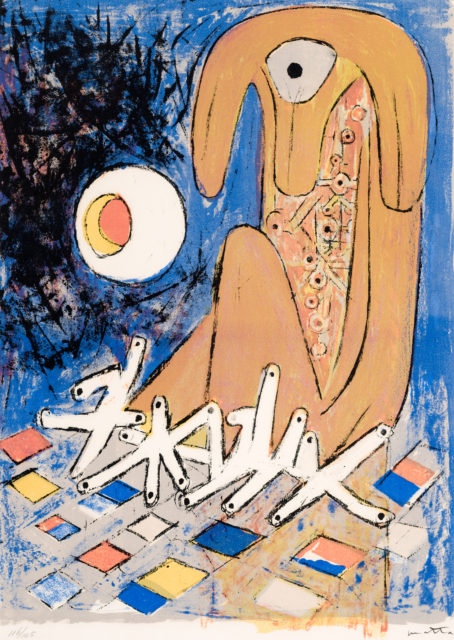DC3594. Roberto Matta, Unknown title, n.d. Lithograph, ed. 116/125, 23 ¾ x 16 ¾ in. Gift of John Welsh III, Class of 1959.
When I first saw Matta’s lithograph, my first impression was that I was looking at a one-eyed dog turned into some sort of clock. The work catches your eye with its clash of geometric shapes and textured lines, combined with vivid colors. I’ve never been all that interested in abstract art—it’s complicated and harder to interpret than a classic bowl of fruit, but Matta’s piece keeps your gaze moving throughout his piece as you go from one bizarre element to the next.
Roberto Matta was one of Chile’s most famous painters and made lasting contributions to the art world through his unique blend of surrealist and abstract expression. Born in Santiago, he studied architecture at the Pontificia Universidad Católica de Chile before joining the studio of the Modernist architect Le Corbusier in 1932. During Matta’s time working in Europe, he was introduced to the renowned Surrealist Salvador Dalí, who encouraged him to pursue a career in art. In 1938, Matta joined a group of Surrealist artists in New York and begin oil painting, but was later ostracized by them for his indirect involvement with the death of his friend Arshile Gorky. Matta returned to Europe and remained there until his death in 2002. His works can be found in many museums around the world including the Tate Gallery in London, the Museum of Modern Art in New York and the Peggy Guggenheim Collection in Venice. Many of Matta’s pieces draw inspiration from his political beliefs and reflections, particularly during the 1940’s and 1950’s, but when discussing his works he also noted “I am interested only in the unknown and I work for my own astonishment.”
Certainly, Matta’s lithograph astonishes most viewers. First, there’s the “dog” with the inside of its body appearing to be composed of a network of cog-like structures. Then, the brightly colored checkerboard in front of said dog, plus a hollowed out sphere that also looks like an eyeball. The juxtaposition of these strange images does what most surrealist works do: take us out of our comfort zone while getting our creative brains going.

